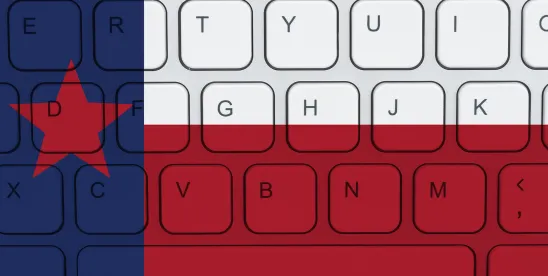At the end of June, Texas enacted the “Texas Responsible Artificial Intelligence Governance Act” (the “Act”), adding to the patchwork of growing AI laws. This summary addresses the Act’s most significant provisions.
Scope & Requirement of the Act
The Act applies to any party who: (a) promotes, advertises, or conducts business in Texas; (b) produces a product or service used by residents of Texas; or (c) develops or deploys an artificial intelligence system (an “AI System”)[1] in Texas.[2] The foregoing also extends to certain governmental entities that leverage AI Systems. Significantly, a “consumer” for purposes of the Act, is limited to residents of Texas acting only in an individual or household context (i.e. excluding commercial activities).[3]
Among regulated parties, the Act assigns duties based on the party’s role, which includes both deployers (i.e., a party who deploys an AI System for use in Texas),[4] as well as developers (i.e., a party who develops an AI System that is offered, sold, leased, given, or otherwise provided in Texas).[5] The Act imposes a number of duties and prohibitions on regulated parties, including at a high level:
- Manipulation of Human Behavior – Developers and deployers are prohibited from intentionally using AI Systems to promote or encourage self-harm, violence, or criminal acts.[6]
- Social Scoring – Government entities are prohibited from leveraging AI Systems to categorize individuals based on their social behavior or characteristics for the purpose of assigning “social scores” that could result in detrimental or unfavorable treatment that is unjustified or unrelated to the nature or severity of observed behaviors or characteristics, or that would contravene rights guaranteed under applicable laws, including but not limited to the U.S. Constitution as well as the Texas Constitution.[7]
- Transparency – Governmental entities that makes an AI System available to consumers must provide clear, conspicuous, and easily understandable notice that such consumers are interacting with an AI System, either before or at the time of engagement.[8] Similarly, where an AI System is used in relation to a health care service or treatment, the provider must provide a similar notice to the recipient of the service no later than the date the service is first provided, except in cases of emergencies.[9]
- Biometric Data Protections – Governmental entities may not use AI Systems to uniquely identify a consumer using biometric data sourced from publicly available information without that consumer’s consent, if such conduct would violate applicable laws.[10]
- Unlawful Discrimination – AI Systems must not be developed or used with the intent to infringe, limit, or otherwise impair consumer rights protected by the U.S. Constitution or with the intent to unlawfully discriminate against consumers of a protected class in violation of federal or state law.[11] The existence of disparate impact alone does not demonstrate intent to discriminate.[12]
- Sexually Explicit Content Involving Minors – Regulated parties may not develop or deploy AI Systems with the sole intent of producing or distributing AI-generated child pornography or “deepfake” sexual content depicting minors.[13]
Sandbox Program
The Act also establishes a “sandbox” program which permits qualifying participants to test certain AI Systems without obtaining the licenses or permits that would otherwise be required.[14] Aspiring participants must seek approval from the Texas Department of Information Resources and any applicable state agency before testing an AI System within the sandbox program.[15] Notably, the sandbox program is slated for a thirty-six (36) month period.[16]
Texas Artificial Intelligence Council
The Act also establishes the Texas Artificial Intelligence Council, which is charged with: (i) overseeing that AI Systems are used in an ethical manner and developed in the public’s interest; (ii) ensuring that AI Systems used in Texas do not harm public safety or undermine individual freedoms by making recommendations to the legislature; and (iii) making recommendations to the applicable state agencies addressing use of AI Systems with an aim to improve efficiency and effectiveness, among other activities.[17] The Council will be a part of the Department of Information Resources.[18]
Enforcement & Penalties
The Act empowers the Texas Attorney General with the authority to enforce the Act and expressly nullifies any city or county ordinance regulating AI.[19] Where there is a determination that a party has violated the Act, the Texas Attorney General must notify the pertinent party in writing of such determination, must identify the specific provisions which appear to have been violated, and must provide the party with an opportunity to cure the identified violation within sixty (60) days following the notice.[20] Notably, the Act expressly states that it does not create a private right of action for individuals.[21] Further, the Act arms the Texas Attorney General with the power to assess civil penalties, to pursue injunctive relief, as well as to seek recovery of attorney’s fees, court costs, and investigative expenses.[22] The Act authorizes civil penalties ranging from $10,000 to $12,000 for curable violations, $80,000 to $200,000 for non-curable violations, and $2,000 to $40,000 per day for continued violations.[23] Separately, the Act also permits state agencies to impose sanctions against parties licensed, registered, or certified by such agency.[24]
It is important to note that the Act prohibits the Texas Attorney General from pursuing “charges against a participant within the sandbox program for violation that occurs during the testing period.”[25] Similarly, the Act also prohibits state agencies from filing or pursuing punitive action against participants.[26]
Moving Forward
The Act is scheduled to take effect on January 1, 2026. Regulated parties should take advantage of the pre-implementation window to assess their use of AI Systems and to take the steps necessary to ensure compliance with the Act (e.g., use case analysis, sandbox program participation, notice, and risk framework alignment).
FOOTNOTES
[1] The Act defines an “artificial intelligence system” as “any machine-based system that, for any explicit or implicit objective, infers from the inputs the system receives how to generate outputs, including content, decisions, predictions, or recommendations, that can influence physical or virtual environments.” Tex. Bus. Code § 551.001(1).
[2] Tex. Bus. Code § 551.002.
[3] Tex. Bus. Code § 551.001(2).
[4] Tex. Bus. Code § 552.001(1).
[5] Tex. Bus. Code § 552.001(2).
[6] Tex. Bus. Code § 552.052.
[7] Tex. Bus. Code § 552.053.
[8] Tex. Bus. Code § 552.051(b)-(c).
[9] Tex. Bus. Code § 552.051(f).
[10] Tex. Bus. Code § 552.054.
[11] Tex. Bus. Code §§ 552.055, 552.056.
[12] Tex. Bus. Code § 552.056(c).
[13] Tex. Bus. Code § 552.057.
[14] Tex. Bus. Code § 553.051. We note that the Act does not specifically address what licenses, registration, or other regulatory authorization requirements participants are exempt from.
[15] Tex. Bus. Code § 553.052.
[16] Tex. Bus. Code § 553.053.
[17] Tex. Bus. Code § 554.001(a).
[18] Tex. Bus. Code § 554.001(b).
[19] Tex. Bus. Code § 503.101(a).
[20] Tex. Bus. Code § 552.104(a)-(b).
[21] Tex. Bus. Code § 503.101(b).
[22] Tex. Bus. Code § 552.105.
[23] Tex. Bus. Code § 552.105.
[24] Tex. Bus. Code § 552.106.
[25] Tex. Bus. Code § 553.051(c).
[26] Tex. Bus. Code § 553.051(d).





 />i
/>i
